Tours of Cypress Cemetery
The Cypress Cemetery Association conducts tours of the cemetery upon request. Led by Association and Old Saybrook Historical Society Trustee J. H. Torrance Downes, the tours focus on the lives of many of those buried in the cemetery. Discussions include the cemetery's relation to the orginal Saybrook Colony settlement and highlights many of the notable Saybrook residents who lived and died here in Old Saybrook.
Saint John's School Tour, Fall 2013
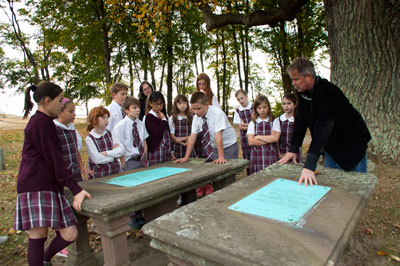
On Wednesday, October 30, 2013, the fifth grade class at Saint John's School in Old Saybrook hiked down to Cypress Cemetery for a morning tour with Cypress Association member J. H. Torrance Downes. The first thing the students learned was that there were several early English settlements in Connecticut, including one at Saybrook Point (the two that preceeded the Saybrook Colony was the colony in Hartford/Wethersfield and in New Haven - the Saybrook Colony, however, was built as a fortification, the first in Connecticut). They also learned that Engineer Lion Gardiner was the one hired to plan the town where "gentlemen" and "men of quality" would live upon arrival from their native England. It was Gardiner's job to lay out the road, the house lots and build a pallisade wall to protect the colonists from Native Americans. They also learned that at that time - 1635 - Gardiner laid out the "ancient burial ground" now known as Cypress in order to accommodate those who died during those rough early days. In the photo at right, the class learns about the Nathaniel Lynde family (Suzanna Willoughby Lynde on right, Nathaniel Lynde on left, surrounded by students).
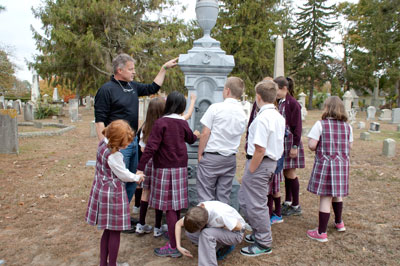
As with the other tours, the students learned about Native American burials, the Lynde family, the "slaves" buried in Cypress, a 14 year old Daniel Williams who was in the wrong place at the wrong time and was killed by British soldiers in the Battle of Groton Heights during the Revolutionary War, and other stories. They learned about the orientation of the graves (north-south), headstones and footstones, a single metal tombstone (photo at left, marketed as "white bronze", but actually made of zinc by a single company out of Bridgeport that no longer exists), the fact that many early settlers may actually be buried under College Street when the cemetery boundaries weren't so clear, and of Saybrook families like the Harts. They learned of the assasination of Captain David Newell in a "mutiny" on his slave ship off the coast of Africa. Finally, to a cheer of excitement, we settled in to talk about Lady Fenwick and the fact that she was originally buried down by the river, only to be moved to Cypress Cemetery when the railroad was to be built in 1870, 225 years after her death and burial. The students also learned that Yale University, the internationally famous Ivy League school in New Haven, actually began as the Saybrook Collegiate School on Saybrook Point (the question was asked, why was "College Street" was named as it was, which the students all answered immediately!).
The class left understanding that cemeteries aren't only about death and dying, but of lives lived, of history and how important that is to our lives today.
Old Saybrook Historical Society Tour, Fall 2013
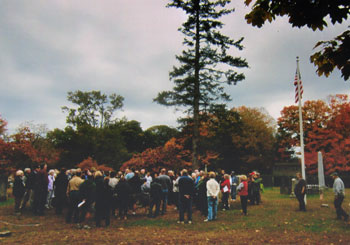
On Saturday, October 19, 2013, over 100 members of the Old Saybrook Historical Society (OSHS) and possible future members of the OSHS convened at Cypress Cemetery for an hour tour led by Cypress Cemetery Association member and OSHS Trustee J. H. Torrance Downes. The great interest in the tour was joyfully overwhelming and tested the vocal strength of Mr. Downes (he was told that everyone was able to hear everything said!). The $5.00 donation by each person will be used to benefit the historial society and was greatly appreciated. OSHS trustees and members including Tedd Levy, Linda Kinsella and Diane Hoyt assisted in organizing the tour.
In a change from past tours, the group walked from the College Street driveway gate south to the southwest corner of the cemetery property, discussing Harry Gilbert Faulk and Anna James along the way. Harry was a twenty year old kid from Saybrook who was killed in action in World War I (the only Saybrook resident to be killed in action in WWI). Anna James, or "Miss James" as she was known, was the first black female pharmacist in the country. She ran James Pharmacy for years and served the likes of Katharine Hepburn and many others in town. She lived in the back of the pharmacy and died in 1977. She's buried with her brother Fritz in Cypress.
From there, the discussion turned to Native American burials, the Lynde family and their large farm located on Lynde Point across South Cove (also known as the Borough of Fenwick). Rose and Phyllis Jackson, and Frank Ransom, "slaves" buried in the southeast corner of the cemetery, and Saybrook slavery in general were discussed. It was noted that they were buried adjacent to the area that has been newly expanded in Cypress where almost 400 burial plots are available for sale (a small sales pitch).
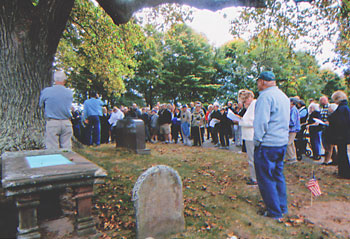
New information discussed included data on the cause of death of many of those buried in Cypress for the 50 years between 1783 and 1832, information gleaned from a record of burials in Saybrook between those years (an expanded version of this investigation is being developed and will be posted on the Cypress website in the near future). Everyone was fascinated to learn that the leading cause of death during that time was consumption (tuberculosis), followed by infant mortality and then typhus fever. Common reasons for death also included drownings, apoplexy (likely strokes and heart attacks), palsy, dropsy (swelling, now known as edema that could be a result of congestive heart failure), canker rash (scarlet fever), lung fever (pneumonia) and other exotic and less exotic causes including death by accidental gunshot, suicides, and "child bed fever" (septicemia caused by germs transmitted by doctors/midwives who had no idea that unwashed hands caused disease). How about death by a pair of "unruly" steers as was the case with Samuel Whittlesey at age 81. The death of Captain David Newell at the hands of captured slaves off the coast of Africa was discussed (is he buried in Cypress or was it more likely his body was simply thrown overboard?).
Essex Cub Scout Troup Tour, March 2013
On Saturday, March 2, 2013, Assocation member J. H. Torrance Downes was pleased to take the young men from Essex Cub Scout Troop, Den 4, Pack 5, on a tour of the cemetery. The Scouts agreed that most times they come to a cemetery, its usually for reasons that aren't so happy, like funerals of loved ones. They were told, however, that a cemetery - especially an historic cemetery like Cypress which dates back to the beginning of the English colonies that made their way to America in the early 1600's - is a place to talk about the lives of those buried there. Stories of people who lived a long time ago, people who liked to laugh like we do today, had favorite foods like we have and had family that they loved like we do. We agreed that cemeteries don't really have to be thought of as scary places!
Among things discussed were the "famous" and the "not quite as well known" people that were buried in Cypress. Famous people discussed included Nathaniel Lynde who was a wealthy businessman who also gave back to the community by donating his house to the fledgling Saybrook Collegiate School, later to become Yale University. And Thomas Buckingham, an early reverend who was one of the trustees who brought the collegiate school to Saybrook Point (ever wonder why College Street has that name?) and who was important to the early days of Congregational Churches in Connecticut. There was also "not quite as well known" Samuel and Ann Doty, who made bread in their bakery at the corner of Cromwell Place and North Cove Road (then called Fenwick Street and Water Street, respectively) to sell for use on ships anchored at the wharves in North Cove.
And, of course, we talked about Lady Fenwick and the fact that she had died giving birth to her second daughter and was buried down near the river. The Scouts learned that, when the railroad was to be built in 1870 (225 years after Lady Alice died and was buried), the towns people got together and removed Lady Alice so that she could be buried at Cypress Cemetery. She was given a full funeral ceremony at the Saybrook Congregational Church, presided over by Reverend S. McCall (also buried in Cypress), placed in a new coffin, and ceremoniously carried down to the cemetery where she was buried in her present spot near College Street. Again, so many great questions and observations were made by the Scouts. They left agreeing that Cypress Cemetery is a place they'd like to come back to visit again.
Old Saybrook Historical Society Tour, Fall 2012
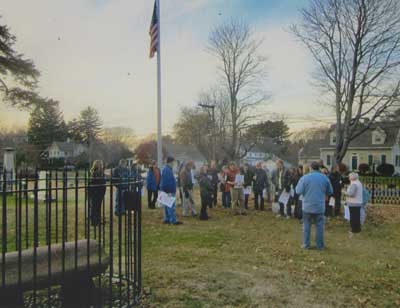
The fall tour of Cypress was postponed twice, first because of Hurricane Sandy and then by a snow storm. Following rescheduling, a fairly good size crowd was able to make it. The tour included a discussion of Colonel George and Lady Alice Fenwick, the Harts, Daniel Williams, Azariah Mather, Thomas Buckingham, the Tullys, the Lyndes and others. Several maps printed on a single 11"x17" placard were given to attendees. Many good questions were asked, and those in attendance offered information they were aware of that allowed for plenty of "sharing" of history. The tomb of Lady Alice Fenwick is seen in the left foreground of the photo at right. Association member J. H. Torrance Downes is seen in the center wearing a red sleeveless vest.
Saint John's School Tour, Fall 2012
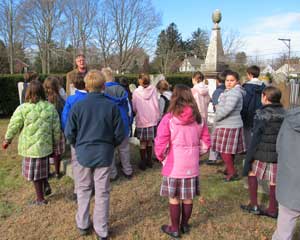
On November 22, 2012, a third grade class from Saint John's School in Old Saybrook made their way down to Cypress Cemetery from their school on Main Street. Tours with children are always special as they have so much interest and ask the most intuitive questions! We discussed topics including why the graves are oriented north-south (most old graveyards have burials with an east-west orientation so that, during resurrection, the deceased will rise up facing the sunrise), why the inscriptions on headstones face north (so you don't have to stand on the grave to read it), and what was the purpose of all of the small markers in between the headstones (footstones!). We noticed that the many veterans of wars dating back to the Revolutionary War had larger footstones than others and that those footstones were inscribed with the veteran's war service information. We talked about many of the important colonists buried in Cypress including the Lyndes, the Buckinghams, the Dotys, the Harts, Lady Alice Fenwick and others. We also talked about the marked graves of three "servants" (which some call slaves) located in the southeast corner of the cemetery.





